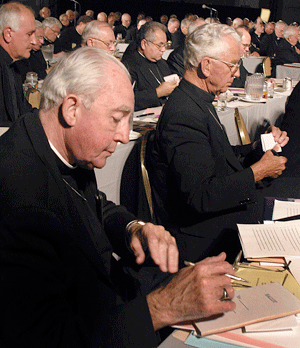WASHINGTON (CNS) — The “Charter for the Protection of Children and Young People” — now 10 years old — was not meant to be “the last word” in solving the abuse crisis, according to the chairman of the U.S. bishops’ Committee on the Protection of Children and Young People.

Instead, Bishop R. Daniel Conlon of Joliet, Ill., said the charter has provided a framework for ongoing efforts. Its requirements are “not a temporary fix” but have to “become part of our culture,” he added.
The charter was part of the U.S. bishops’ response to the clergy abuse scandal that was a top concern when they met 10 years ago in Dallas.
Their June meeting took place just five months after The Boston Globe began publishing articles about the sexual abuse of minors by priests and accusations of a systemic cover-up by church officials. The reports prompted other victims across the country to come forward with allegations of abuse that put the scandal in the national spotlight.
The bishops responded by developing a national policy to oust predators and protect children. They adopted the charter and approved a set of legislative norms to enforce implementation in all dioceses. They also established a lay-run National Review Board to monitor compliance, commission studies of the causes and context of the crisis, and recommend further actions. Later that year, the bishops formed a national Office for Child and Youth Protection.
A decade later, the review board was scheduled to report on the effectiveness of the bishops’ response to the abuse crisis at their June 13-15 meeting in Atlanta.
According to Al J. Notzon III, chairman of the National Review Board, “striking changes” have occurred in the church’s efforts to prevent and report abuse but said more work still needs to be done.
The charter outlined how the church leaders would provide a safe environment for children and young people in church-sponsored activities. It established uniform procedures for handling sex-abuse allegations and adopted a “zero tolerance” policy. It also required background checks and training in child protection for church employees and required dioceses facing allegations made about priests or other church workers to alert authorities, conduct an investigation and remove the accused person from duty.
Deacon Bernard Nojadera, head of the U.S. bishops’ Secretariat of Child and Youth Protection, said even with these efforts, many Catholics are often unaware that the church has taken such an active role to stop and prevent abuse.
In part, this stems from “pockets of allegations” that continue to surface, he said.
Notzon also said that many Catholics do not know what the church is doing to stop abuse and said people often suggest to him that the church do things it is already doing.
“Word needs to get out about what’s being done,” he told Catholic News Service May 25 from his San Antonio home.
He said the general public also should know what the church is doing since abuse is a societal problem. “The church is on the leading edge and needs to share its information and let others know there are valuable things they can learn without the pain the church had to go through.”
When abuse allegations emerge in the church, he said, they could stem from a failure to implement charter policies, which the review board investigates.
Notzon said in recent years the church has changed the way it treats victims from “immediately getting defensive” with them to taking a more pastoral role. He also said the credibility of the audit — measuring how dioceses comply with the charter — has improved. “Compliance auditors are trained to look to make sure not just the law but the spirit of the law is followed.”
The bishops’ level of commitment to the issue proves they know the charter is something that needs to be “supported over time,” he added, noting that the review board’s role is to “continually hold up a mirror to the bishops to say, ‘Here is your commitment and here is your response.'”
A report released in April on the implementation of the charter showed that nearly all U.S. dioceses are in full compliance.
James Marasco, director of StoneBridge Business Partners, the Rochester, N.Y., company that conducted the most recent audits, said in the audit that StoneBridge hopes to help the U.S. Catholic Church “continue to restore the trust of the faithful and heal the wounds caused by abuse.”
Deacon Nojadera said healing is still a major aspect of the crisis as the church continues its outreach to survivor victims and families and address how abuse affected the entire church.
“As with any deep wound, it takes time to heal,” said Bishop Conlon.
He said the church’s efforts to restore credibility “take a step forward and then a step backward,” noting that when church officials do not follow protocol for reporting abuse it “sets things back for all of us.”
The bishop said he is grateful to pastors and laypeople who have taken a leadership role at diocesan and parish levels to raise awareness of abuse, put standards of safety and codes of conduct in place to make the church a safe place for children.
“I want to encourage everyone to stay the course,” he told CNS May 25.
“We have to make assurances that what happened in the past never happens again,” he added, noting that church officials have to be “as transparent as we possibly can and have to be prayerful about it.”
— By Carol Zimmermann, Catholic News Service






